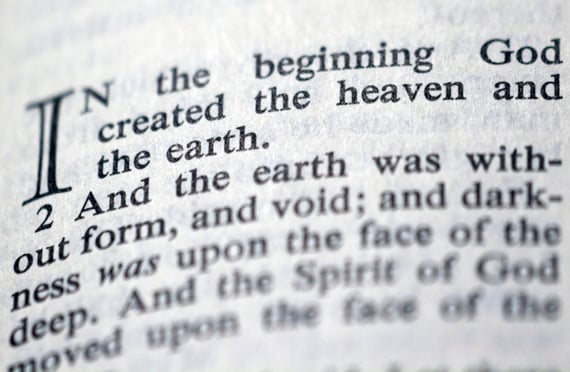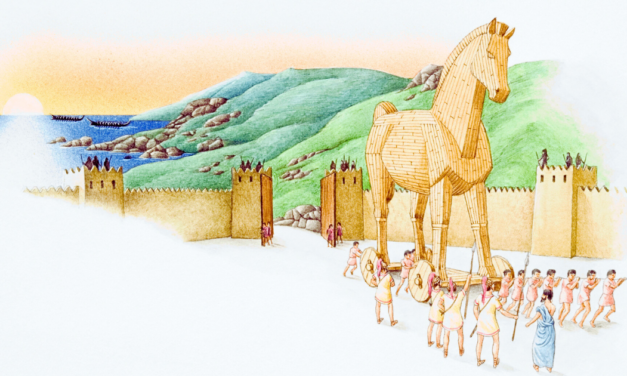This article first appeared in the Practical Hermeneutics column of the Christian Research Journal, volume 35, number 01 (2012). For further information or to subscribe to the Christian Research Journal go to: http://www.equip.org
The slander of jaded secularists to the contrary, most Bible-believing Christians are aware that not everything in the Bible is to be taken literally. When the Bible says “the eyes of the LORD run to and fro throughout the whole earth” (2 Chron. 16:9, all Scripture quotations from the ESV), no one imagines that God literally has eyes, much less that they “run” throughout the earth. This is an anthropomorphism—that is, a description of God in human terms. Because humans were made in the image of God, we can gain some insight into God’s invisible, incorporeal, and spiritual nature by ascending from the earthly replica to the heavenly reality on which the earthly replica was modeled.
The Framework. While it is widely recognized that the Bible contains figurative and nonliteral language, it has been less widely recognized that the days of creation described in the first chapter of the Bible may also be plausibly viewed as a figure of speech. Many evangelicals are convinced that the days of creation are literal, twenty-four-hour days, but there are indications in the text that suggest that we are in the presence of another metaphor. Along with several other scholars, I hold to a nonliteral interpretation of the days of Genesis called “the framework interpretation.” It is called that because the days of creation are viewed as a literary framework. The framework interpretation is the view that Moses presents God as a worker who goes about His creative work in six days and rests on the seventh day, and that this picture functions as a literary framework in which the creative acts of God are narrated in a nonsequential or topical order. The days of creation are presented as ordinary solar days, complete with mornings and evenings, but taken as a whole, the picture of God working for six days and resting on the seventh is anthropomorphic. The narrative of God’s creative activity within the six days corresponds to events that occurred in space and time, but the seven-day week is a literary device for organizing that historical narrative, and so that aspect of the narrative (the framework of the seven days) is not to be taken literally. Though the days are a literary framework, the events of creation narrated within the framework are real historical events. The days are like picture frames. The snapshots within each frame are historical, but the frames provide a literary structure for narrating the creation history in a topical (i.e., nonsequential) order.
Moses himself appears to have consciously shaped his account using the creation days as a literary device to provide his account with an intricate structure that has theological significance. There are a number of contextual clues in the inspired text that encourage us to view the creation days as a literary framework.
Clues in the Construction. The first clue is the fact that the six days are divided into two triads with strong parallels between each of the days in the two triads; that is, parallels between days one and four, days two and five, and days three and six. Day one describes the creation of light and the establishment of day and night, while day four describes the creation of the luminaries to govern the day and the night. Day two narrates the creation of the firmament, which divides the waters above (the sky) from the waters below (the seas), while day five narrates the creatures that inhabit the sky and the seas. On day three, God forms the dry land and the vegetation that grows on the dry land, and on day six He creates the living creatures that dwell on the dry land, including man. There is also a thematic link between the vegetation of day three and man on day six, a linkage that is spelled out in Genesis 2:9, 16–17 where God places before man a test involving vegetation (the tree of the knowledge of good and evil).
Poetry with a Purpose. The second contextual clue is the fact that the first two members of the triad (days one, two, four, and five) each narrate one creation event while the third members of the triad (days three and six) both narrate two creation events. Higher critics have often pointed out that the eight creative acts (the “let there be” statements, or fiats) appear to be incongruous with the six days. They interpret this alleged discrepancy as evidence that the so-called priestly author took a pre-existing narrative of eight creation events and reformulated it to fit his six-day structure due to his interest in Sabbath theology. But as those who honor the divine inspiration of Scripture, we recognize that Moses himself was shaping his narrative, consciously putting two fiats on days three and six in order to bring out the parallelism of the two triads. This adds a kind of poetic weight to the last member of the triad and creates momentum as the narrative segues into the crowning Sabbath day.
Expanding on a Theme. A third clue of the presence of a literary framework is the fact that days one and four are so closely connected that they are best viewed as narrating the same event from different points of view. Day one narrates the creation of light. We are also told that “God separated the light from the darkness” (Gen. 1:4). Day four narrates the creation of the luminaries (the sun, moon, and stars). Strikingly, on day four we are told that the reason God created the luminaries was to accomplish the separation that was already narrated on day one: “Let there be lights in the expanse of the heavens to separate the day from the night” (Gen. 1:14). Rather than viewing this as a redundancy, we should recognize that day four is an instance of “temporal recapitulation.” This phenomenon of biblical narrative occurs when the author first narrates an event in summary fashion, continues with subsequent events as the narrative unfolds, and then returns to the initial event to elaborate on it with further detail (e.g., compare Gen. 1:26–27 with 2:5–7, and compare Gen. 2:8–9 with 2:15–17). Days one and four are not referring to different events, but to the same event viewed from different perspectives. Day one narrates the basic result; day four narrates the creation of the mechanism that is the physical cause of that result (e.g., the earth-Sun relationship).
Eternal Rest. Finally, we must note the fact that the seventh day of the framework lacks the concluding statement, “and there was evening and there was morning, the seventh day.” This suggests that the seventh day is eternal. This view is supported by the commentary of the author of Hebrews, who states that the seventh day is still ongoing (Heb. 4:1–11). If the seventh day is eternal, then it is not a literal day. This in turn encourages us to take the six days of creation, which together with the seventh day form a metaphorical week of days, not as a literal chronology but as a literary framework for organizing the historical events of creation in a topical order.
Why did Moses employ the anthropomorphic picture of God going about His creative labors in six days and resting on the seventh? He did so in order to communicate a theological message. The key is to observe that the first triad of days narrates God’s establishment of the major realms or kingdoms of creation and the second triad narrates God’s making the creatures that function as the vice-regents or kings under God that rule over the realms or kingdoms. Then, all the created realms and regents of the six days are subordinated to God Himself as the great King over all as He is enthroned in His royal Sabbath rest on the seventh day. Thus the seventh day marks the climax of the creation week. The theological point of this literary structure is that the creation was made by God to be subordinate to man and through man’s obedient work as God’s regent exercising dominion over creation to enter God’s own rest. God’s purpose for creation was, through Adam’s obedience, to be ultimately transformed and glorified in order to be the theater of God’s glory and the eternal dwelling place of glorified humanity. Adam and Eve were not created to live in the Garden of Eden forever. They were created to pass the test by not eating of the forbidden tree and then, having been confirmed in righteousness, to eat of the tree of life and live forever with God in glorified bodies in a glorified cosmos.
The seventh day was a sign and foretaste of creation’s hope of reaching its consummation goal in eternal union and communion with the triune God. Moses’ depiction of God’s work-rest pattern in Genesis 1 was modeled after man’s work-rest pattern, because man was made in the image of God. Therefore, just as man was to work for six days and then rest on the seventh, so Moses pictures God as working for six days and then entering His eternal rest as a sign to Adam that his work would ultimately lead him and all of creation to enter God’s eternal rest as well. Of course, Adam disobeyed God, failed the test, and was expelled from the garden. The remainder of the Bible narrates how God did not let Adam’s failure be the last word, but in His grace He sent His Son to be the second Adam who would obey where the first Adam failed, so that through His obedience all those who are united to Him by faith might enter God’s eternal rest in the new creation.
The literary framework of the two triads is so pronounced that it suggests that Moses chose to present God as a workman whose creative work occupied a “week” in order to give his creation account a literary structure that carries with it a profound theological message. Moses’ anthropomorphic depiction of God’s work “week” communicates the message that the creation was made to glorify God and to enjoy Him forever.
| CREATION KINGDOMS | CREATURE KINGS |
| Day 1. Light | Day 4. Luminaries |
| Day 2. Sky Seas |
Day 5. Sea Creatures Winged Creatures |
| Day 3. Dry land Vegetation |
Day 6. Land Animals Man |
| THE CREATOR KING Day 7. Sabbath |
|
Lee Irons, Ph.D., contributed to a book titled The Genesis Debate: Three Views on the Days of Creation (ed. David G. Hagopian; Crux Press, 2001). He maintains a website of biblical and theological studies at www.upper-register.com.









